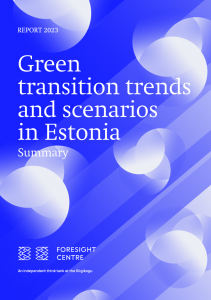Green Transition Scenarios in Estonia

This research stream considers the possible economic and social impacts of the green transition, identifying the main vulnerabilities. What could Estonia expect under different scenarios for the green transition? How might our understanding of a competitive business environment change during the green transition?
The European Commission announced on 11 December 2019 that the green transition should simultaneously:
– bring greenhouse gas emissions into line with the capacity of the environment to absorb them;
– make the European economy more competitive;
– protect, preserve and increase the environmental capital of the European Union;
– protect the health and well-being of citizens from environmental dangers and impacts; and
– be fair and inclusive.
The ability of Estonia to reduce its carbon dioxide emissions fast enough has been analysed in detail in recent years, but several fundamental questions remain. Should a nuclear power plant to be built in Estonia or not, how much forest should be felled, and should natural resources be mined or not? Urban sprawl and mobility based on the car will be decisive for whether the goals of the green transition can be achieved, so will these trends continue or can they be redirected?
The transition will change the business models of companies and with them the expectations for the business environment. A key question is how and with what the economy will fill the space that is left when companies with unsustainable business models exit the market. We will probably need regulations to encourage the circular economy, good access to the raw materials that are critical for a green economy, digital infrastructure that allows data to be shared securely, and much more. The development monitoring of the green transition seeks answers to the question of how our understanding of a competitive business environment might change during the green transition. What new factors will be of critical importance?
This is all related to the broader social impact of the green transition and a possible increase in inequality as society is divided between sectors and companies that are winners and losers from the green transition. Directing the environmental impacts into the prices of products and services will raise the price level and could make it hard for some people to cope. How should the costs of the green transition be divided fairly across different groups in society? How can the green transition be made to create value for those people whose main worry is coping day to day?
The research stream considers the central choices needed to make the green transition happen, and analyses what alternative scenarios would be created by the different choices and combinations of choices for carrying through the green transition in Estonia.
Each scenario starts from the European Commission’s declaration and considers:
- the possible impact on the business environment and the competitiveness of the economy;
- the possible impact on the optimal level of use of Estonia’s natural resources; and
- the broader social impact through the distribution of income, inequality and more.
Reports linked to the research
News linked to the research
-
22.10 2024Estonian companies’ involvement in green investment is similar to the rest of Europe
According to the Foresight Centre’s short report “Green investment trends of companies in Estonia and Europe”, Estonian companies’ involvement in green investment is similar to the rest of Europe, although considerably fewer companies invest in energy production.

 An independent think tank at the Riigikogu
An independent think tank at the Riigikogu 

